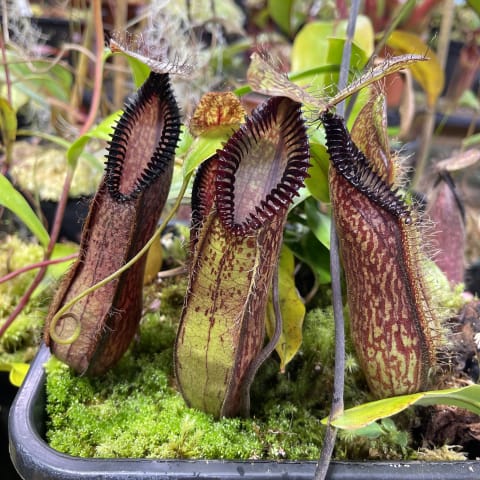There’s a lot to know about these plants, as shown by the countless hobby groups and specialty retailers dedicated to studying them. But consider this your quick introduction to what pitcher plants are, what makes them special, and how to grow lower-maintenance varieties indoors at home. What makes both types of Nepenthes special is the way they have adapted to survive in their native habitats. These plants have long grown in nutrient-poor soil, so they’ve needed to devise other methods for getting valuable minerals. That’s where the “pitcher” part of their name comes in; over time, Nepenthes have developed modified leaves that lure and trap prey. These funky leaf sacs look like pitchers of water, and each one can hold up to 3.5 liters of digestive fluid (that’s nearly 15 cups’ worth!). Once the plant catches an animal, it digests it in this pitcher fluid to extract the nutrients it isn’t getting from its soil. Nepenthes come in all shapes and sizes, and they can sustain themselves using this unique pitcher adaptation for a long, long time. Carnivorous plant specialist Damon Collingsworth notes that he’s kept his first Nepenthes for over 30 years now, and the nursery he owns, California Carnivores, has ones dating back to the Victorian era. These days, most tropical pitcher plants you find in stores will be hybrids that are bred to be more resilient, but you can find rarer species in specialty shops like Gravine’s and Collingsworth’s. In addition to pitchers that turn prey in nutrients, this plant also has standard leaves that photosynthesize to make sugars from the sun. You can find Nepenthes that don’t have any pitchers and just look like a typical green houseplant, but this isn’t a great sign. While a plant can survive with no pitchers, it won’t thrive unless it’s catching prey. “If it has more than two names in it, it’s usually an easy-to-grow plant,” he explains, due to what’s known as hybrid vigor. “When you cross two different species together, that genetic difference tends to make the hybrids more vigorous. Those will be easier to grow,” echoes Collingsworth. Here are the two Nepenthes hybrids you’re the most likely to find in your neighborhood plant shop, probably hanging in a basket. Both are relatively easy to care for at home: “If you don’t have that strong light, you can grow them under grow lights,” adds Collingsworth. He suggests running a full-spectrum light for 12 to 14 hours daily within 8 to 10 inches of your plant to keep it happy. When taking home a new tropical pitcher plant, you can also place it in an enclosed environment like an empty fish tank or large terrarium to get it acclimated to your space. This will better replicate the humid conditions it probably grew accustomed to in the nursery: Put your plant in a closed space to start, to trap moisture, and then gradually pull back the lid off the container over the course of a few days. Plants don’t like drastic changes, Gravine explains, but “as the plant gets a feel for the light and the conditions, you can get it out into the house a little more.” “They require more attention in the beginning,” he notes, “but once you get the hang of them, they’re pretty easy.” You’ll likely need to water your Nepenthes every one to two weeks depending on your home’s conditions and the time of year. When you do, don’t use any old tap water, Collingsworth warns. “All carnivorous plants need to have distilled water or rainwater. Tap water can kill them,” he says, due to its high mineral concentration. Instead, Collingsworth explains that they’ll be happier in a substrate like Sphagnum moss, which is loose and airy but still retains moisture. Perlite and coconut coir can also be incorporated to create a chunky blend for this plant, adds Blocker. Temperatures between 65 and 85 degrees Fahrenheit should be suitable for most Nepenthes, especially those low-maintenance hybrids. Keep in mind that your Nepenthes may not produce as many pitchers during the shorter, colder winter months. It’s a good idea to repot your Nepenthes in fresh substrate every few years. (Here’s a guide to the repotting process.) If you notice that your plant has become root-bound in its current pot, move it to a container that is one size larger. There are a few ways to feed pitchers indoors, and you might want to experiment to see which one works best for you and your plant. Here are the methods that have worked for the pros: Emma received her B.A. in Environmental Science & Policy with a specialty in environmental communications from Duke University. In addition to penning over 1,000 mbg articles on topics from the water crisis in California to the rise of urban beekeeping, her work has appeared on Grist, Bloomberg News, Bustle, and Forbes. She’s spoken about the intersection of self-care and sustainability on podcasts and live events alongside environmental thought leaders like Marci Zaroff, Gay Browne, and Summer Rayne Oakes.




